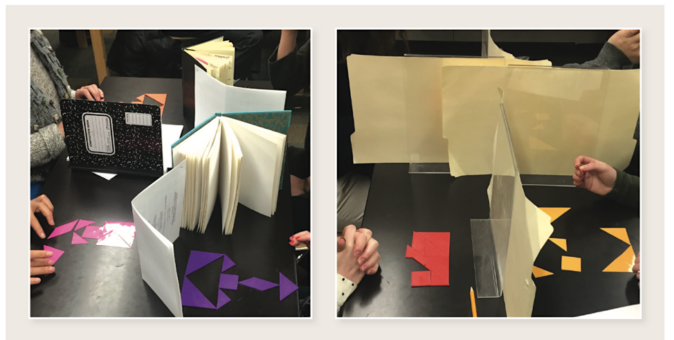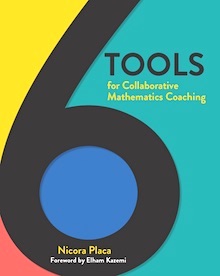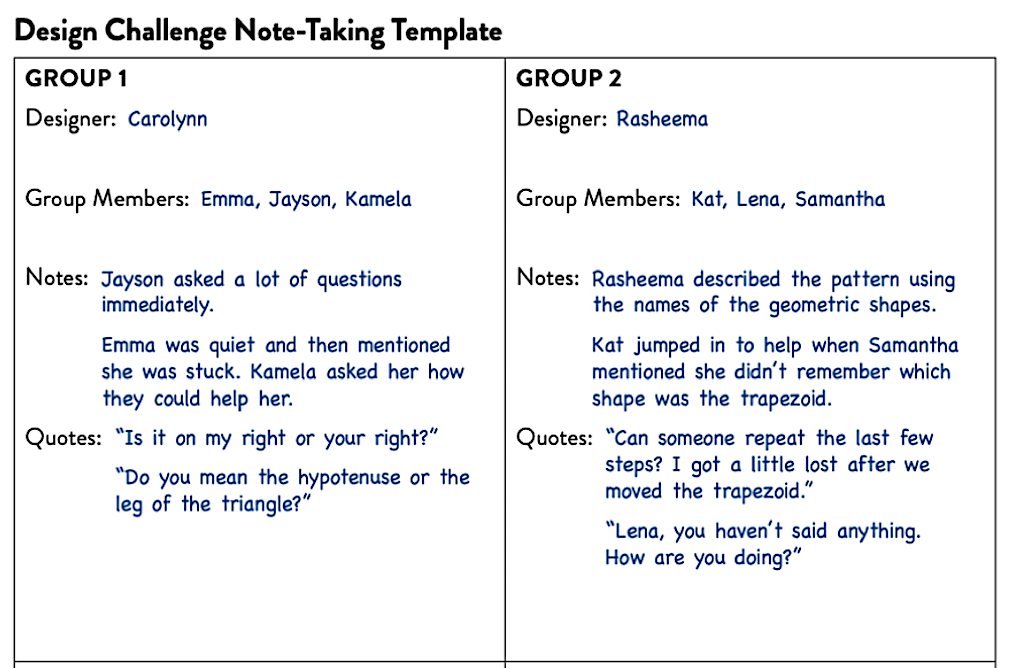Coaching Math Teachers in Collaborative Teams
A former NYC elementary and middle school math teacher, Dr. Nicora Placa is a teacher educator, teaching coach, and the author of the bestselling 6 Tools for Collaborative Mathematics Coaching (Stenhouse, 2023). In this post Nicora looks at fostering a learning community among math teachers.
By Nicora Placa

Recently I received a call to do some coaching work with a new middle school math team. The administrators and I met to discuss the school’s goals and needs for the upcoming school year. We talked about the value of viewing coaching as a collaborative endeavor where I would work alongside the teachers to foster learning opportunities.
I shared some guiding principles I use to think about the ways teachers grow professionally.
Teacher learning occurs when…
- Teachers have opportunities to construct knowledge on their own as opposed to following a model of how to teach.
- Teachers have opportunities and time to explore different ideas and practice new skills.
- Teachers are encouraged to take risks and make mistakes.
- Teachers have opportunities to examine and discuss other teachers’ work and strategies.
- Teachers sometimes work in whole groups, small groups, and individually with the coach.
What coaching is and isn’t
For me, coaching is not teaching a new strategy; coaching is about providing tools to evaluate and think about new strategies together. It’s about creating safe communities for teachers where they are willing to take risks and feel vulnerable.
Effective coaching is about curating resources and sharing new research and strategies with teachers who don’t have time to read through all the new ideas that are out there. It’s helping them find solutions to address needs and questions they express and then providing structures and support to learn about, implement, and reflect on those strategies.
We begin by building community
After our discussion the administrators’ first question was: “How do we begin?” For me, that answer is similar to how we begin our work with students. When we are teaching students math, we spend time building community in our classrooms at the start of the year so that we can effectively engage them in learning math.
I have found this time investment is equally important in my coaching work. Building teacher teams helps set the groundwork for successful implementation of other collaborative coaching tools, such as learning walks or lesson study.
When I initially started coaching, I used a fun math brain teaser or icebreaker to get started, but I started to realize that these familiar activities did not always accomplish my goal of getting us to collaborate.
I began to look for activities that created the need to collaborate – that had an entry point for all and would create some fun and excitement around our work together. I also chose activities that teachers could modify and use with their students, so that they would walk out of our session with something they could immediately bring back to their classrooms that aligned with our goals of having students work collaboratively.
Let’s take a closer look at one activity I have found successful in my work with math teams: the Design Challenge.
The Design Challenge: Effective Group Work
Elizabeth Cohen, Rachel Lotan, and their colleagues at the Stanford School of Education have designed research-based activities with the goal of fostering equity by allowing opportunities for all students to be successful in heterogeneous classrooms.
Their “Complex Instruction” tasks are intended to make norms for group work explicit. Although the activities are designed for teachers to use in their classrooms with students, I have found that they are easily adaptable to teacher teams themselves – and that facilitating them is a good way to set (or re-set) norms for teachers working together.
The activities work nicely for teacher teams because group work can sometimes be just as challenging for teachers as it is for students. Using these tasks has helped me bring some of these grouping issues forward in a nonthreatening way so we can think about how to navigate them together.
Although I use many of the Complex Instruction tasks, my favorite is my adaptation of their Master Designer activity. I call it the Design Challenge.
The Design Challenge
Group size: Four team members
Materials:
- A set of geometric blocks for each team member. They must be exactly the same. I use either tangrams or pattern blocks.
- I normally use two-pocket folders to create a divider between the members so that no one can see anyone else’s workspace.
- A timer.
Goal: To recreate the original design that one team member has created.
Rules:
- A designer is randomly assigned. This person uses the shapes to create any design they want.
- After the designer has created their (hidden) design, they explain how to create the design so that the other three team members can create the same image. They can use words, hand signals, and gestures.
- The team members can ask questions of the designer as well as of each other.
- When a group member thinks they have created the same design, the creator checks the design. If the member is correct, they are responsible for joining the designer in explaining how to create the design.
- The group work is not done until all members are done with one design. If the group finishes and there is still time remaining, a new person takes on the role of the designer.
As the groups are working on the task (as seen in the picture below), you can circulate, observe, and take notes. This note-taking template may help you organize your observations.

When I facilitate, I try to record things I notice or comments I hear that might be helpful to discuss in the debrief. For example, I might record the confusion one team member was having about the orientation of the right triangle and how using more precise mathematical vocabulary (i.e., hypotenuse, legs) was helpful, but only for those members who were familiar with the vocabulary. Sometimes team members will remember these specific comments, but it’s helpful to have them written down in case they don’t. You can see some more examples below (click to enlarge).
From 6 Tools for Collaborative Mathematics Coaching by Nicora Placa ©2023. Stenhouse Publishers, reproduced with permission of Stenhouse Publishers.
While I circulate, I also look for the unique qualities of the individuals on the teams. What do they bring to the group? Who has a great rapport with the other team members? Who observes first and thinks carefully before asking questions? Who asks interesting questions? These observations will help me think about how to build on strengths and strategically group our teams for later learning activities.
After the groups have completed the activity, I facilitate a discussion with the following questions. Team members reflect independently first, then discuss in small groups, and then share out to the whole group.
► What was difficult about communicating in your group?
► What were some effective ways your group communicated?
► If you did this activity again with a new designer, what would you do differently?
During the whole-group discussion, I use my observation notes to strategically select which groups I would like to share out. This allows me to focus our discussion and address issues that team members might not necessarily volunteer or choose to share.
For example, I might notice that one member of a group kept interrupting others and another group member asked them to let them finish their question. I might ask the group how they might navigate situations when a group member doesn’t feel like they are being heard.
After this share, we then go to a second set of questions that focuses on the implications for our work moving forward. The goal is to leave the discussion and activity with an initial set of norms for communicating within groups. I again have the team reflect individually first, then in pairs or small groups, and then as a whole team.
► What can we do as a team to ensure all of our group members are able to share their ideas?
► What are the implications of what we noticed during this activity for our communication as a group?
► What are some norms we can agree to as a group in terms of communication?
This activity allows us to begin a conversation about communication in our work together. It also allows me, as the coach, to assess what work will need to be done to continue the conversations. For example, after completing this activity, one teacher noted how having the shared goal of everyone creating the design helped her to stay engaged, even after she knew her design was correct. She liked that she then became a designer and helped give directions.
I pushed the group to think about what that observation meant for our work as teachers as well as for our work as learners together. We came up with a shared norm that when we worked in teams, our goal was to make sure that we all understood the content or the details of a particular strategy before we moved on, and that it was everyone’s responsibility to help one another understand new content or strategies.
Setting a foundation this year
As you begin thinking about the upcoming school year, you may want to consider how to modify this activity or others like it to start to build your own learning communities and set the foundation for a successful year of working collaboratively.

Currently, Nicora is an assistant professor at Hunter College where she teaches and develops high quality clinical experiences for pre-service educators, while also conducting research on professional learning. She also continues to work with schools and districts to provide collaborative coaching and professional learning supports for in-service teachers and administrators. Follow her on Twitter @nicoraplaca and visit her website to access more free math coaching tools and resources.






























